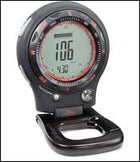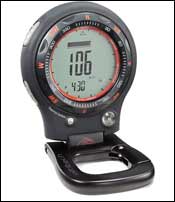You’re right, Killaine. Basically all altimeter watches are somewhat monstrous. The trimmest option seems to be the Timex ║┌┴¤│ď╣¤═° Tech Altimeter ($100), which has a relatively unobtrusive one-inch face. That’s something of an improvement, seeing as most watch faces in this style are in the beefy two-inch realm. One would think a style-savvy company such as Nike would have conquered this challenge and developed a slim altimeter watch, but its current offering┬Śthe Nike Oregon Series Alti Race ($159; www.nike.com)┬Śhas a two-inch face and looks like something the Special Forces would wear.
 Highgear AltiTech II
Highgear AltiTech II
Options? Not many. I might suggest a non-watch-style altimeter that clips to your clothing or slips into a key pocket on your running shorts. That would be something such as Highgear’s AltiTech II ($150; www.highgear.com), which is an excellent watch and altimeter but trades off a little bulk for an easy-read display and a relatively low price. A somewhat similar item is the Brunton Nomad V2 ($119), which is designed to be carried on a lanyard around your neck or otherwise attached to your person.
So there are some solutions for you. I certainly understand that when you want to keep track of elevation and other things, you want it in the most convenient manner, and wrist-mounted devices fulfill that admirably. If you do have regular trails you run, one trip could be used to determine the elevation gained and loss, and then you could simply build your runs around that known information┬Śforegoing a watch entirely.
Pick up a copy of the 2006 ║┌┴¤│ď╣¤═° Buyer’s Guide, on newsstands April 25, for a look at 396 torture-tested products, including the 2006 Gear of the Year award winners and an all-new women-specific review section.


